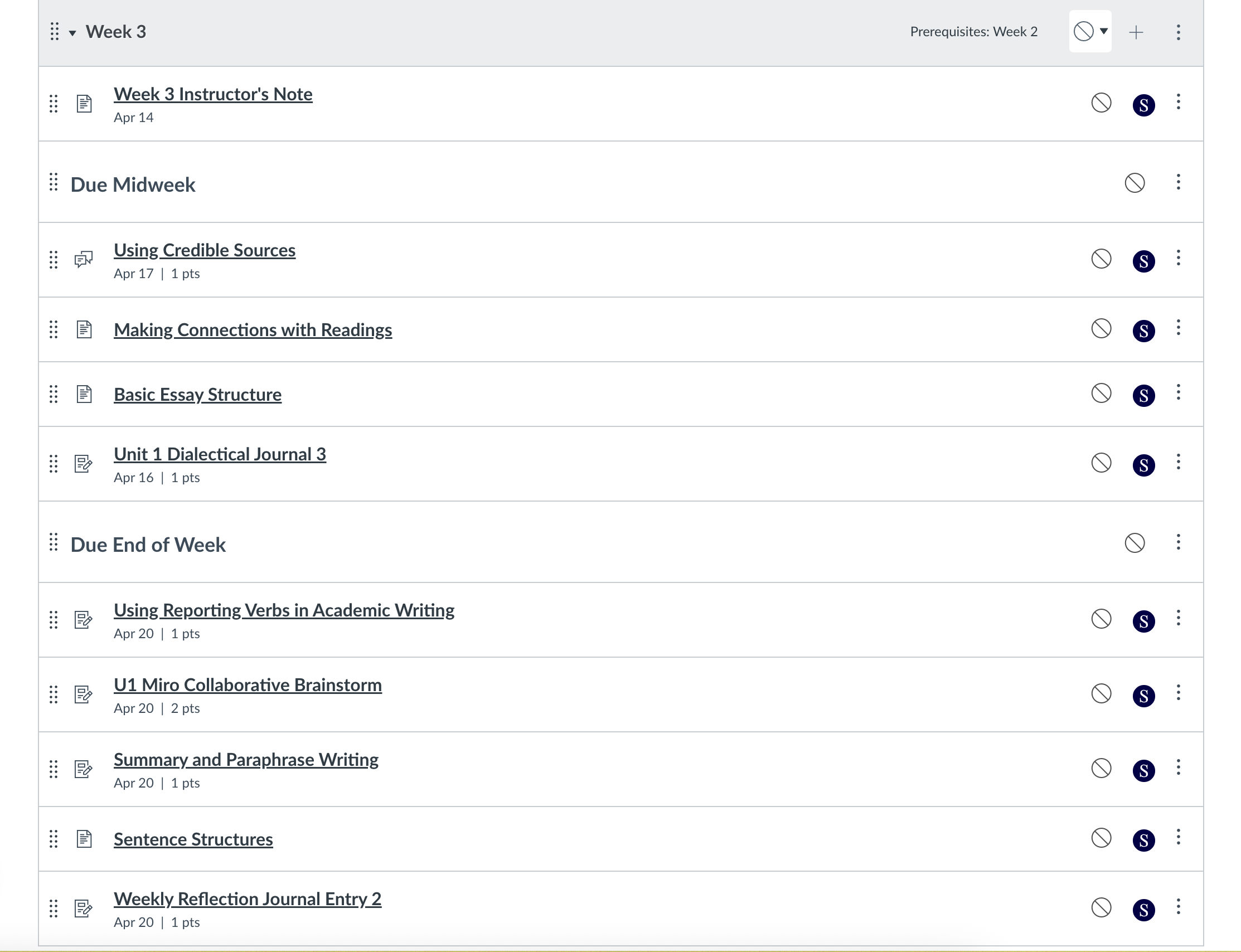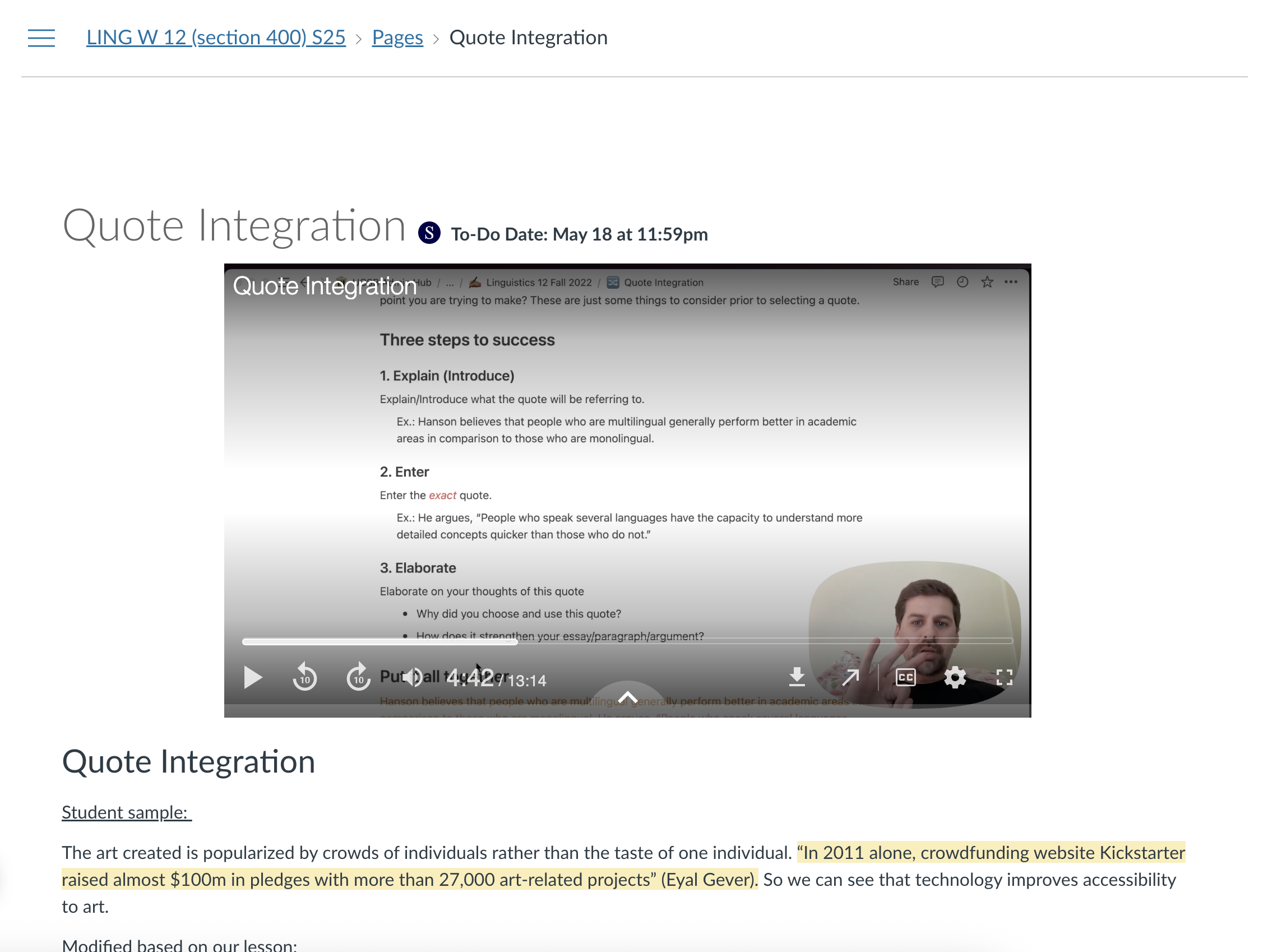Case Study 1: Transforming Linguistics 12 for Digital Learning
Course Context
Linguistics 12 was originally designed as a traditional in-person course heavily dependent on classroom-based activities including discussions, reflective writing, collaborative reading, and interactive Q&A sessions. The challenge was to transform this highly interactive course into an effective online and hybrid learning experience without sacrificing the depth of engagement or quality of learning outcomes.
Key Challenges
- Maintaining the collaborative nature of process writing in an asynchronous environment
- Preserving the spontaneity and depth of in-class discussions when students work independently
- Creating effective alternatives for collaborative activities originally designed for face-to-face settings
- Ensuring students could engage deeply with complex linguistic concepts without immediate instructor feedback
- Developing a format that would support different learning styles and schedules while maintaining academic rigor
Process and Approach
Analysis Phase
I began by identifying which elements of the in-person course were most valuable to student learning and which aspects presented the greatest challenges in a digital environment. Through careful mapping of learning objectives to activities, I determined which components required reimagining versus which could be adapted with minimal changes.
Design Methodology
Using the ADDIE model (Analysis, Design, Development, Implementation, Evaluation), I approached the transformation systematically:
- Analysis: Identified core learning objectives and essential activities
- Design: Created new activity structures leveraging Canvas LMS capabilities
- Development: Built the course environment with integrated digital tools
- Implementation: Deployed the course with clear student guidance
- Evaluation: Gathered feedback and performance data for iterative improvement
Technology Selection
Given that Canvas was the university’s standard LMS, I focused on integrating tools that would elevate the learning experience rather than act as digital replacements for in-person tasks:
- Canvas LMS: Core platform for content
organization, assessment, and communication
- Discussion Boards: Structured for deeper, more reflective conversations than typically possible in time-limited classroom settings
- Google Docs: Enabled dialectical journals and collaborative annotation
- Miro: Facilitated visual thinking, concept mapping, and structural planning
Accessibility Considerations
I incorporated Universal Design for Learning principles throughout by:
- Providing multiple means of engagement through varied activity types
- Offering content in different formats to accommodate diverse learning preferences
- Creating flexible scheduling within weekly parameters to support different working styles
Solutions Implemented
Course Structure Redesign
I transformed the course structure from a bi-weekly, in-person meeting format to an asynchronous online approach with:
- Weekly learning modules with clear objectives and expectations
- Scaffolded activities that build upon each other
- Integrated reflection points throughout each module
- Developed several innovative approaches to maintain the interactive nature of linguistics study:
Interactive Elements
Dialectical Journals via Google Docs
Transformed traditional reading responses into dynamic, layered conversations where:
- Students annotate readings directly in the document
- Peers engage with each other's annotations, creating threaded conversations
- Interactive brainstorming sessions that remain persistent for continued development
- Outline development with visual organization of arguments and supporting evidence
Visual Thinking via Miro Boards
Leveraged digital whiteboards to enhance conceptual understanding through:
- Collaborative concept mapping for linguistic theories
- Visual relationship building between different readings and concepts
- Instructor can provide targeted feedback within the actual context of discussion
- Thought development becomes visible over time as students revisit and expand on ideas
Asynchronous-to-Synchronous Workflow
For the hybrid version, I designed a workflow where:
- Students complete preparatory work independently online (such as readings)
- In-person sessions focus on deeper application of concepts through small group work
- Online follow-up activities build on in-person breakthroughs
- The learning cycle creates continuity between digital and physical spaces
Technology Integration
I utilized Canvas LMS features strategically to enhance learning:
- Developed sequenced modules with prerequisite requirements to ensure proper scaffolding
- Implemented automatically-scored formative assessments for immediate feedback
- Utilized the calendar and announcement features to maintain consistent communication
- Embedded and linked to external tools (Google Docs, Miro) within Canvas for seamless student experience
Engagement Strategies
To maintain high engagement in the asynchronous segments:
- Designed activities requiring peer interaction and feedback
- Created opportunities for student choice in topics and approaches
- Implemented varied assessment methods to accommodate different strengths
- Developed a consistent rhythm of deadlines within flexible weekly timeframes
Outcomes and Impact
Learning Benefits
The transformed course demonstrated several advantages over the original format:
- Deeper Reflection: Extended time for processing complex linguistic concepts led to more thoughtful analysis
- Visible Thinking: Digital tools made student thinking processes more transparent
- Persistent Discussions: Conversations developed over longer periods with greater depth than in-time-limited classroom settings
- Flexible Engagement: Students could interact with materials at optimal times for their cognitive engagement
- Enhanced Collaboration: Digital collaboration tools allowed for more equitable participation than traditional in-class discussions
Student Experience
The redesigned course format provided students with:
- Greater agency in managing their learning schedule
- More opportunities for revision and refinement of ideas
- Reduced anxiety for students who find spontaneous in-class contributions challenging
- Increased accessibility for students with varied life circumstances and learning needs
Instructional Advantages
From an instructional perspective, the transformation resulted in:
- More detailed visibility into student thinking processes
- Better tracking of individual contributions to group activities
- Enhanced ability to identify misconceptions early through digital activities
- Streamlined feedback processes through integrated digital tools
Visual Examples



Reflection on Learning
This project deepened my understanding of how technology can enhance rather than merely replace traditional learning experiences. By focusing on the unique advantages of digital tools rather than simply replicating in-person activities, I was able to create learning experiences that in many ways surpassed the original course design.
The most valuable insight was discovering how asynchronous activities can lead to deeper processing and more thoughtful contributions when properly structured. This transformed my approach to instructional design, leading me to consider how every learning activity might benefit from a combination of synchronous immediacy and asynchronous reflection.
Additionally, this project reinforced the importance of intentional technology selection. Each digital tool was chosen specifically for how it enhanced a particular learning objective rather than for convenience or novelty.